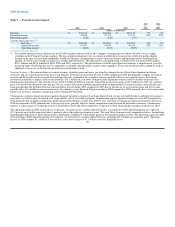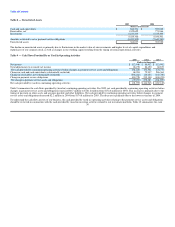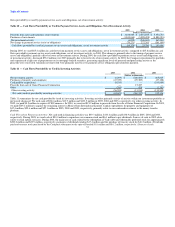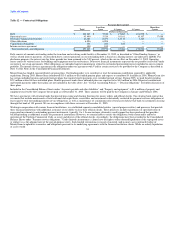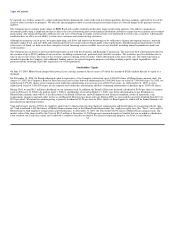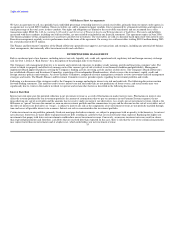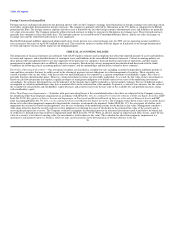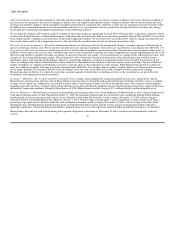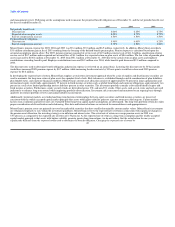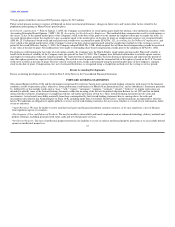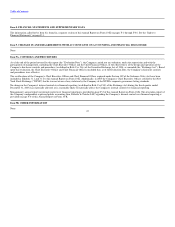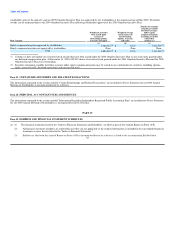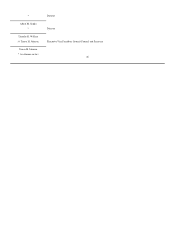MoneyGram 2005 Annual Report Download - page 41
Download and view the complete annual report
Please find page 41 of the 2005 MoneyGram annual report below. You can navigate through the pages in the report by either clicking on the pages listed below, or by using the keyword search tool below to find specific information within the annual report.
Table of Contents
Foreign Currency Exchange Risk
Foreign currency exchange risk represents the potential adverse effect on the Company's earnings from fluctuations in foreign exchange rates affecting certain
receivables and payables denominated in foreign currencies. The company is primarily affected by fluctuations in the U.S. dollar as compared to the British
pound and the Euro. The foreign currency exposure that does exist is limited by the fact that foreign currency denominated assets and liabilities are generally
very short-term in nature. The Company primarily utilizes forward contracts to hedge its exposure to fluctuations in exchange rates. These forward contracts
generally have maturities of less than thirty days. The forward contracts are recorded on the Consolidated Balance Sheets, and the net effect of changes in
exchange rates and the related forward contracts is not significant.
Had the British pound and Euro appreciated (depreciated) up to twenty percent over actual exchange rates for 2005, pre-tax operating income would have
seen an increase (decrease) of up to $4.4 million for the year. This sensitivity analysis considers both the impact on translation of our foreign denominated
revenue and expense streams and the impact on our hedging program.
CRITICAL ACCOUNTING POLICIES
The preparation of financial statements in conformity with GAAP requires estimates and assumptions that affect the reported amounts of assets and liabilities,
revenues and expenses, and related disclosures of contingent assets and liabilities in the consolidated financial statements. Critical accounting policies are
those policies that management believes are most important to the portrayal of a company's financial position and results of operations, and that require
management to make estimates that are difficult, subjective or complex. Based on this criteria, management has identified and discussed with the Audit
Committee the following critical accounting policies and estimates, and the methodology and disclosures related to those estimates:
Fair Value of Investment Securities — Our investment securities are classified as available-for-sale, including securities being held for indefinite periods of
time and those securities that may be sold to assist in the clearing of payment service obligations or in the management of securities. These securities are
carried at market value (or fair value), with the net after-tax unrealized gain or loss reported as a separate component of stockholders' equity. Fair value is
generally based on quoted market prices. However, certain investment securities are not readily marketable. As a result, the fair value of these investments is
based on cash flow projections that require a significant degree of management judgment as to default and recovery rates of the underlying investments.
Accordingly, the estimates determined may not be indicative of the amounts that could be realized in a current market exchange. The use of different market
assumptions or valuation methodologies may have a material effect on the estimated fair value amounts. In general, as interest rates increase, the fair value of
the available-for-sale portfolio and stockholders' equity decreases and as interest rates fall, the fair value of the available-for-sale portfolio increases, along
with stockholders' equity.
Other Than Temporary Impairments — Securities with gross unrealized losses at the consolidated balance sheet date are subjected to the Company's process
for identifying other-than-temporary impairments in accordance with SFAS No. 115, Accounting For Certain Investments in Debt and Equity Securities, EITF
Issue No. 99-20, Recognition of Interest Income and Impairment on Purchased and Retained Beneficial Interests in Securitized Financial Assets and SEC
Staff Accounting Bulletin No. 59, Views on Accounting for Noncurrent Marketable Equity Securities. The Company writes down to fair value securities that it
deems to be other-than-temporarily impaired in the period the securities are deemed to be impaired. Under SFAS No. 115, the assessment of whether such
impairment has occurred is based on management's case-by-case evaluation of the underlying reasons for the decline in fair value. Management considers a
wide range of factors about the security and uses its best judgment in evaluating the cause of the decline in the estimated fair value of the security and in
assessing the prospects for recovery. The Company evaluates investments for beneficial interests in structured investments rated A and below for which risk
of credit loss is deemed more than remote for impairment under EITF Issue No. 99-20. When an adverse change in expected cash flows occurs, and if the fair
value of a security is less that its carrying value, the investment is written down to fair value. The evaluation for other-than-temporary impairments is a
quantitative and qualitative process, which is subject to risks and uncertainties in the determination of whether declines in the fair
38


